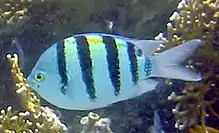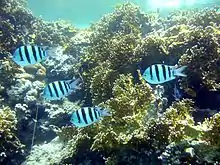Indo-Pacific sergeant
The Indo-Pacific sergeant (Abudefduf vaigiensis) may also be known as the Sergeant major although this name is usually reserved for the closely related species Abudefduf saxatilis.
| Indo-Pacific sergeant | |
|---|---|
 | |
| Scientific classification | |
| Kingdom: | Animalia |
| Phylum: | Chordata |
| Class: | Actinopterygii |
| Family: | Pomacentridae |
| Genus: | Abudefduf |
| Species: | A. vaigiensis |
| Binomial name | |
| Abudefduf vaigiensis | |
| Synonyms[2] | |
Distribution

The Indo-Pacific sergeant is found in the Indo-Pacific including the Red Sea.[3]Indian Ocean populations are found in the Red Sea, the Gulf of Aden, Arabia, the Persian Gulf, the Arabian Sea, the Maldives, eastern Africa, Madagascar, Seychelles, Sri Lanka, the Andaman Sea, Indonesia, Malaysia, and Australia.[3] Populations in the Pacific Ocean are found in the Gulf of Thailand, Malaysia, Indonesia, the Philippines, Taiwan, Japan, the Yellow Sea, the Great Barrier Reef around Australia, New Zealand, and Pacific islands all the way to Hawaii.[3] They were also recently thought to have been found in the Mediterranean Sea[4] but it has been found that the majority, if not all, of the specimens from the Mediterraean are of Abudefduf saxatilis, an Atlantic species.[5]
Description
Abudefduf vaigiensis are white bluish with a yellow top. They have a black spot around their dorsal fin. It has yellow eyes. The dorsal fin on this fish has 13 dorsal spines and 11 to 14 dorsal soft rays.[3] The anal fin on the Indo-Pacific sergeant has 2 anal spines and 11 to 13 anal soft rays.[3] Its maximum recorded size is 20 centimetres (7.9 in).[3] Juveniles mature at 12 centimetres (4.7 in).[3] Males turn more blue during spawning.[3] Many people confuse this fish for Abudefduf saxatilis, a closely related species found in the Atlantic Ocean.[3]
Ecology
Diet
They feed on zooplankton, benthic algae, and small invertebrates.[6]
Habitat
Adults live in coral reefs, tide pools, and rocky reefs.[3] Larva of this species live in the open sea.[3] It is found in tropical and subtropical waters. Depth ranges of 1 to 15 metres (3.3 to 49.2 ft) are where people encounter this fish.[3]
In the aquarium
This fish is found in the aquarium trade.
Life Cycle
References
- Allen, G.; Williams, J.T.; Larson, H. & Burt, J. (2017). "Abudefduf vaigiensis". IUCN Red List of Threatened Species. 2017: e.T188609A1901550. doi:10.2305/IUCN.UK.2017-2.RLTS.T188609A1901550.en.
- "Synonyms of Abudefduf vaigiensis (Quoy & Gaimard, 1825)". FishBase. Retrieved 4 October 2018.
- Froese, Rainer and Pauly, Daniel, eds. (2007). "Abudefduf vaigiensis" in FishBase. May 2007 version.
- Siliotti, A. (2002) fishes of the red sea Verona, Geodia ISBN 88-87177-42-2
- Rami Tsadok; Maxim Rubin-Blum; Eli Shemesh & Dan Tchernov (2015). "On the occurrence and identification of Abudefduf saxatilis (Linnaeus, 1758) in the easternmost Mediterranean Sea" (PDF). Aquatic Invasions. 10 (1): 101–105. doi:10.3391/ai.2015.10.1.10.
- Lieske, E. and Myers, R.F. (2004) Coral reef guide; Red Sea London, HarperCollins ISBN 0-00-715986-2
- "Abudefduf vaigiensis" Encyclopedia of Life Retrieved on December 21, 2014
Further reading
- Coleman, Richard R.; Gaither, Michelle R.; Kimokeo, Bethany (November 2014). "Large-scale introduction of the Indo-Pacific damselfish Abudefduf vaigiensis into Hawai'i promotes genetic swamping of the endemic congener A. abdominalis". Molecular Ecology. 23 (22): 5552–5565. doi:10.1111/mec.12952. PMID 25283736.
- Maruska, Karen; Peyton, Kimberly (April 2007). "Interspecific Spawning between a Recent Immigrant and an Endemic Damselfish (Pisces: Pomacentridae) in the Hawaiian Islands". Pacific Science. 61 (2): 211–221. doi:10.2984/1534-6188(2007)61[211:isbari]2.0.co;2. hdl:10125/22609.
- Tsadok, Rami; Rubin-Blum, Maxim; Shemesh, Eli; Tchernov, Dan (21 May 2014). "On the occurrence and identification of Abudefduf saxatilis (Linnaeus, 1758) in the easternmost Mediterranean Sea" (PDF). Aquatic Invasions. 10 (1): 101–105. doi:10.3391/ai.2015.10.1.10. Retrieved 29 April 2015.
External links
- Fishes of Austraila : Abudefduf vaigiensis
- Photos of Indo-Pacific sergeant on Sealife Collection

